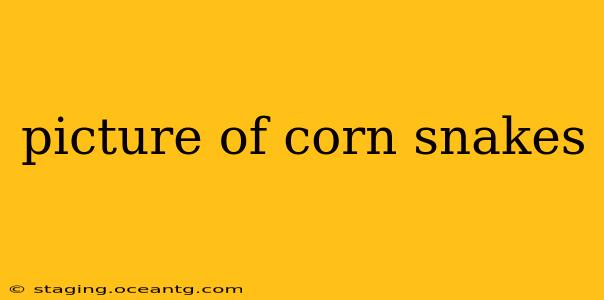A Captivating Glimpse into the World of Corn Snakes
Corn snakes ( Pantherophis guttatus) are captivating creatures, prized by reptile enthusiasts for their docile nature, relatively easy care, and stunning array of colors and patterns. Their beauty and manageable temperament make them a popular choice for both beginners and experienced reptile keepers. This article will explore the visual characteristics of these snakes, delving into their diverse appearances and what makes each corn snake unique.
What do corn snakes look like?
Corn snakes exhibit a wide spectrum of appearances, thanks to extensive breeding programs that have produced a remarkable variety of morphs. The classic corn snake displays a reddish-brown or tan body with darker, saddle-like markings along its back. These markings are typically outlined in black or dark brown. Their bellies are usually a creamy white or yellowish color, often with subtle speckling or darker blotches. However, this is just the beginning of the visual diversity this species offers.
What are different corn snake morphs?
The term "morph" refers to a specific variation in a snake's coloration or pattern, often achieved through selective breeding. Some popular corn snake morphs include:
- Anerythristic: These snakes lack the red pigment, resulting in a mostly gray or tan coloration with darker markings.
- Albino: These snakes lack any melanin pigment, resulting in a pinkish-white body with red eyes.
- Hypomelanistic: These snakes have reduced melanin, resulting in lighter coloration and often muted patterns.
- Lavender: These snakes possess a unique lavender or lilac hue, a result of specific genetic combinations.
- Stripe: This morph features a distinct, continuous stripe along its back, varying in color depending on other genetic factors.
Many other morphs exist, often combining traits from several different ones, creating a near-infinite variety of unique appearances. The complexity of corn snake genetics allows breeders to constantly develop new and visually stunning morphs.
What is the average size of a corn snake?
Adult corn snakes generally reach lengths between 3 and 5 feet. Females tend to be slightly larger than males. However, their size can vary slightly depending on individual genetics and environmental factors.
Are corn snakes venomous?
No, corn snakes are completely non-venomous. They are constrictors, meaning they subdue their prey by wrapping their bodies around them and squeezing until the prey suffocates. This makes them safe to handle (with proper precautions and knowledge of reptile handling) for responsible keepers.
How can I find pictures of corn snakes?
Finding pictures of corn snakes is relatively easy. A simple online search using terms like "corn snake pictures," "corn snake morphs," or "corn snake patterns" will yield countless results. Image search engines like Google Images, Bing Images, and others are excellent resources for finding high-quality images of corn snakes showcasing their diversity. You can also explore various reptile websites and forums where enthusiasts often share photos of their snakes. Remember to always respect the rights of photographers and source any images you use appropriately.
Where can I learn more about corn snake care?
Caring for any reptile requires research and commitment. Reputable websites dedicated to reptile keeping, herpetological societies, and books on reptile husbandry provide comprehensive information on the specific needs of corn snakes. Understanding their dietary requirements, appropriate enclosure setup, and general health considerations is crucial for ensuring the well-being of your pet. Responsible ownership involves understanding your snake's needs and providing a safe and enriching environment.
This exploration of corn snakes hopefully provides a better understanding of their captivating beauty and diversity. With their manageable size, docile nature, and wide range of morphs, these snakes offer a rewarding experience for reptile enthusiasts of all levels. Remember to always prioritize responsible pet ownership.
